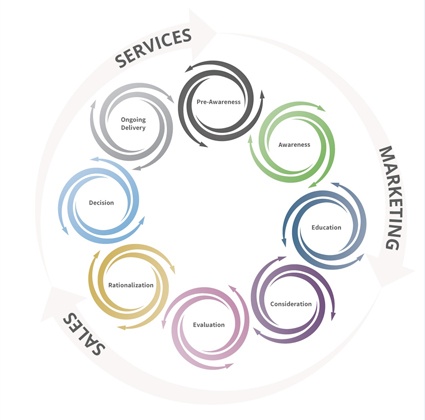
Agencies Are Steering You In The Wrong Direction On Revenue Strategy
Your Business Deserves More Than A Template, Doesn’t It?
 It’s simple for me. Is your business the same as every other business? Is your business the same as your top three competitors? Of course not. Your business is as unique as you are as a leader of the business. Your revenue generation plan, marketing strategy or sales strategy needs to be unique to your business, so why would anyone think you could capture that individuality in a template or form?
It’s simple for me. Is your business the same as every other business? Is your business the same as your top three competitors? Of course not. Your business is as unique as you are as a leader of the business. Your revenue generation plan, marketing strategy or sales strategy needs to be unique to your business, so why would anyone think you could capture that individuality in a template or form?
I used to be an in-house VP of marketing and sales for a variety of different companies in different industries. Every year, we went through the process of creating a revenue generation strategy that took our overall corporate growth goals and mapped them to sales and marketing tactics. Not once did I download a template or think I could use some other company’s plan as our plan.
Your business deserves its own revenue generation strategy and its own plan.
Yet hundreds of people each day download a marketing strategy template from digital marketing agency A, B or C and then go about filling in the blanks. Voila, your marketing strategy is done! Now we can get started on the really important work, like your website, email marketing, blog articles, account-based marketing (ABM) or a whitepaper project. Please, don’t do that; I’m begging you.
Instead, take the time and invest the money or set aside the team to create a revenue generation strategy that is designed specifically for your company, your prospects, your customers, your products/services, your industry and your specific goals or objectives.
Here’s a schematic to follow as you go about doing strategy and planning the right way.
Start With Metrics And Quantitative Goals
You will never get to your goals if you don’t know what they are today. It’s like having a map with no destination. Bigger isn’t specific enough. How much bigger? By when? Are the goals attainable given your constraints, like budget, team or marketplace economics? Every single strategic planning system starts with defining your goals and the time frame for those goals.
Those goals might be high level, like revenue or number of new customers, and that’s a great place to start. But those bigger goals should lead to smaller, shorter-term goals that help you determine whether you’re on track or not. How many visitors do you need to your website to produce a certain revenue level or a certain number of new customers? You should be able to answer that question. Then you can track those leading-indicator metrics weekly in advance of your big goals.
Create Buyer Journey Analytics For Your Current And Future State
I see few companies doing this, but it’s an exercise that produces incredible insight. What does your buyer journey look like mathematically? At each stage of your current buyer journey, what are the conversion rates? What do these conversion rates need to look like to get you to your stated revenue goals? What is the delta between the current state and the future state?
This is an indicator of how much you’ll need to invest and how long you’ll need to wait for that future state. This is a data point you should be aware of before you even start looking for an agency or hiring in-house marketing people, and this should inform your budget decisions.
If you need your current buyer journey metrics multiplied by 10 times to hit your goals, you should be prepared to invest heavily to make that happen, and you should be prepared to wait months for the execution to deliver a 10 times improvement. If you only need to double your current metrics, you can expect this to happen faster and for less investment.
In fact, I wouldn’t even move forward with any agency that wasn’t asking questions around this data, building a future-state buyer journey model and using that to help you understand investment and timing.
Define The Who And The Where
Personas represent one of the easiest aspects of revenue strategy. Everyone knows about them and everyone does them. When we ask prospects, they always have something to show us, but most of the time the personas are incomplete and superficial. You’re going to want to see detailed profiles that include demographic, psychographic and online behavioral information for all of your targeted prospects.
These should look like detailed psychological profiles that the FBI would create, not online dating profiles that you’d see on Match.com. The more detailed your profiles, the better your marketing and sales execution will perform and the faster your programs will generate leads (the quality of those leads will be better, too).
Make Your Business Remarkable
I can’t emphasize enough how important this piece of the puzzle is today. If your business isn’t remarkable, it’s invisible. If it’s not remarkable, any amount of marketing is going to underperform. If it’s not remarkable, you’re going to lose deals to competitors. If it’s not remarkable, there’s no reason for customers to stay with you.
Most agency partners are ill equipped to work you through a series of discussions and sessions that help you uncover what makes you remarkable, but you are wasting money trying to market an unremarkable, ordinary company.
What’s most interesting about the discovery process around making your business remarkable is almost every company we’ve done this with has remarkable elements of their business on day one, but they’re not talking about them or they’re talking about them in the wrong way.
Your business is probably already remarkable and you’re just not leveraging it properly in your marketing, sales and customer services areas.
Build A Story Inventory
This is another underemphasized yet strategically critical area. Your prospects and your customers all relate, remember, share and connect with stories much better than features and benefits, yet companies continue to use features and benefits as the cornerstone of their marketing. Big mistake. Instead, you need to create a story inventory.
A story inventory is a collection of stories for marketing, sales and customer service to roll out when necessary. People remember stories more easily and they share stories more readily. This is key from a marketing and sales perspective. Tell the right story and get a new customer; it’s that simple.
Map Every Single Prospect And Customer Touch Point
 Now that you have some of the foundational strategy work completed (analytics, goals, stories, remarkable aspects of your business and solid persona profiles), you can move onto the tactical execution that everyone gets so excited about. But to know which tactics to deploy and when, you should look at your prospects’ entire buyer journey (starting from before they even knew you existed).
Now that you have some of the foundational strategy work completed (analytics, goals, stories, remarkable aspects of your business and solid persona profiles), you can move onto the tactical execution that everyone gets so excited about. But to know which tactics to deploy and when, you should look at your prospects’ entire buyer journey (starting from before they even knew you existed).
Each stage of the Cyclonic Buyer Journey™ has specific touch points that need to be executed through specific tactics and specific deployment methods. This creates an experience worth noticing for your prospect. Eventually, if you do this well, that prospect will become a customer. That experience needs to continue, so your customers continue to advocate for your business, further driving more referrals and more new business for your company.
The faster the cycle spins, the less friction. This means more revenue generated while investing less money and time in sales and marketing. It’s a connected set of processes, and your job is to make those processes spin faster and more efficiently month over month.
By looking at each touch point, you’ll get an opportunity to experience-map these touch points, to optimize each customer’s experience and to create an even more remarkable business. In addition, this work all goes toward creating a revenue generation machine that produces scalable, repeatable and predictable revenue growth.
Use Our Stairway 2 Heaven Exercise
This effort does produce a long list of ideas, tactics, changes, upgrades, enhancements, additions and supplemental work for almost everyone in the organization. If you do this correctly, you should be looking at organizational transformation, not necessarily in the design of the organization but in what the organization works on and your approach to the business.
To keep this all-in context and get the company focused, we’ve delivered what we call the Stairway 2 Heaven exercise. In this workshop, we help clients define the current state of the business and what the heaven state might look like. We then help them create the series of steps that get them from their current state to their heaven state.
This produces a set of sequential building block steps, tasks or projects required to move the company from current state to heaven state. It can be transformational. But what we love most is it clearly outlines exactly what needs to be done, who has to do it and in what order. Now these tasks can be assigned and executed, with progress up the stairway tracked over time. It has a 100% success rate.
Prioritize In 90-Day And 30-Day Increments
Once you get your team executing, new projects, tasks and initiatives are going to come up. Of course, you still have constraints on the business and your people. Time and budget are typically the biggest constraints. No worries, because we have a prioritization methodology to keep everyone on the same page and make sure priorities align and flow down from the top.
We work with clients to strategically plan in 90-day increments and then tactically plan to execute in 30-day sprints. The larger 90-day strategy alignment helps us thread together four quarters of strategy to deliver overall annual goals, and having the 30-day tactical sprints means we always are working on tactics that roll up to the 90-day plans and overall corporate goals or objectives.
It’s a fool-proof system that makes sure any tactical deliverables are aligned with the overall corporate strategy. It also means prioritization is taking place in an agile way. As new ideas surface, they either push back something else or take a back seat. This prevents you from trying to do too much in a less effective manner.
Again, years of experience have proven this to work exceptionally well. You can do it too with a little practice and discipline.
Overlay Customer Journey Dashboards
How do we link short-term tactical performance with mid-term goals and long-term strategic progress? Customer journey dashboards, of course. Instead of creating custom dashboards with disparate data or data you think you need, we use pre-defined dashboards with the five to seven key metrics for each of the customer journey stages.
Here’s an example for the Awareness Stage of the buyer journey. These are the metrics we track for all customers and for us to see how we’re doing in this important early stage part of the buyer journey:
- Website visitors
- Site-wide conversion rate
- Net new contacts added to the database
- Social reach, followers, connections and friends
- Conversion rate of visitors to sales opportunities
- Visitors from organic search
- Sales-qualified leads from organic search
Yes, there might be other metrics too, and sometimes we’ll supplement this with other data points, but this gives us a good idea as to how the early stages of our buyer journey marketing program are performing.
Apply Technology Strategically
With over 7,000 MarTech and sales-related software tools on the market, it’s easy to be confused or romanced into thinking any of these are going to be the difference between success and failure. The fact is no software solution on its own is going to make or break your revenue growth efforts.
But you do need to create a technology strategy first, one that starts with a system, process or methodology you want to deploy and then maps software to your process, creating a more streamlined, efficient, automated or data-driven process as a result.
We’ll apply the same thinking to software as we do to metrics. Here are the software tools that make the Awareness Stage of the buyer journey more effective, more efficient and a better experience for your prospects:
- SEMrush
- Moz
- Unbounce
- BuzzSumo
- Bizable (acquired by Marketo)
- Full Circle Insights
- BrightFunnel
You wouldn’t use all of them, and you’d probably want to put them on top of a platform option like HubSpot, Marketo, Pardot or Eloqua. But by understanding how you want to use them to improve performance and what areas of the buyer journey you want enhanced, now you have a strategy and process behind any application of technology.
Your chances of seeing quantitative improvement just went up by a factor of 10. This might seem like a ton of work, and it is. It’s the kind of work most companies never do for all of the wrong reasons. It’s the difference between companies that limp along never growing and those that produce the hockey stick growth graphs everyone is aspiring to deliver.
By doing this work before you start working on your blog, website or ABM campaign, you’ll be setting you company up for success based on a clear plan. You’ll get to market faster, you’ll save money in the long run and you’ll end up with a more comprehensive approach to marketing and sales that produces more leads, more sales opportunities and more new customers.
Some of the smartest CEOs I know are astute at recognizing what they’re good at, what they’ve been successful at historically and what they might need some assistance with going forward. They would prefer to bring in someone who has successfully done what they’re trying to do as opposed to trying to do it themselves for the first time.
These planning exercises are challenging. You want your marketing, sales and customer services strategy done efficiently. What should take 30 to 60 days can’t take six months. Better yet, what if it could be done in two days instead of two months? What if you just needed some scheduling and advanced notice? The only way you get all of this strategy work done in two days is if you’ve done it dozens of times previously.
The only way you can get strategy done efficiently is if you have the proven processes, methodology and systems in place.
Square 2 Marketing – Revenue Is Earned Through Experience, Methodology And Insights!

CEO and Chief Revenue Scientist
Mike Lieberman, CEO and Chief Revenue Scientist
Eliminate Hit-or-Miss Marketing Moves
Get advice, tips, tools and guidance to generate more leads for your company in this weekly email newsletter.



Eliminate Hit-or-Miss Marketing Moves
Get advice, tips, tools and guidance to generate more leads for your company in this weekly email newsletter.













